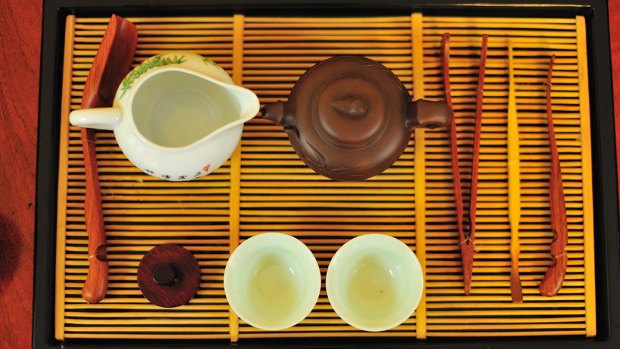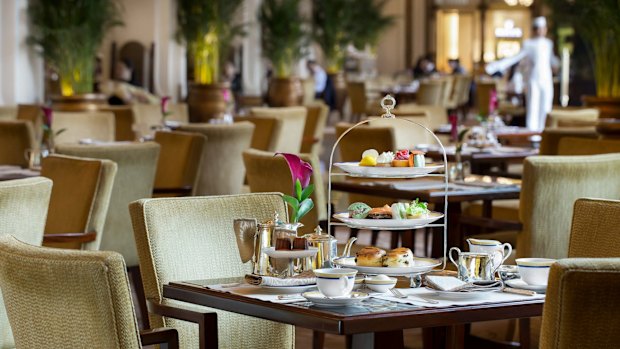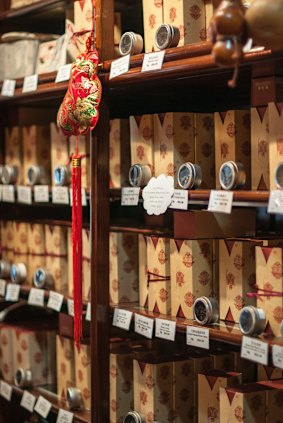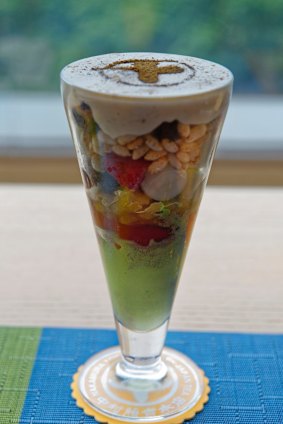This was published 7 years ago
Hong Kong to a tea ceremony: History and culture in a cup

All set for a tea ceremony.
A look of delight spreads across the face of Wingchi Ip. The picture of a Confucian scholar, with his clipped silver goatee, dressed in a simple cotton changshan, he has just brought a cup of Lao Ban Zhang Raw Pu-erh tea to his lips.
"Early spring tea," he says. "Can you taste that? No bitterness or acid taste which would tell you the tea has been picked in summer." It's a robust, earthy flavour with a slightly fruity taste that lingers in the throat. For tea connoisseurs, pu-erh is tea royalty and Lao Ban Zhang, from the high, misty uplands of south-western Yunnan province close to the border with Myanmar, is the king of pu-erh teas.
We have been talking tea for the past 30 minutes and it's a densely woven narrative.

Tea time.
"In the past, after the spring harvest, this tea would have been stored through summer with lots of rain and high humidity. During the winter dry season the tea would begin its long journey by porters and on horseback along the Chamada, the Ancient Tea Horse Road. During the journey it was exposed to fungus and oxidation and sun and rain and by the time it reached Hong Kong it had undergone four or five successive fermentations. Now the tea is stored in plastic bags and transported by truck and we use science to age it and control its fermentation. It's hard to capture the character of the tea of the past, but there's no point being romantic about it."
Ip describes himself as a tea lover, which is a little like saying Usain Bolt is a runner. For many years he has been a significant importer of high quality teas from China to Hong Kong, as well as a calligrapher, painter, academic and a collector of tea paraphernalia, most notably Yixing tea pots.
We are sitting is the LockCha Tea House, an oasis within the leafy surrounds of Hong Kong Park. It's his creation, his personal domain and the synthesis of his ideas about tea and food, aesthetics and leisure and the company of friends and family. It's also gorgeous beyond words, an airy space with dark wooden tables set with geometric arrangements of white bowls and plates and dark wooden chopsticks on bamboo mats. If you were making a movie about old Shanghai and looking for a hangout for intellectuals with Marxist leanings, you would choose LockCha. Naturally, there is also tea for sale, roasted teas, yellow teas, oolong teas and the prized pu-erh. A 50-gram tin of Phoenix Oolong sells for $19, but go highbrow and a cake of 2007 Jingmai Organic Green will set you back $570.

Tea for sale.
If you want to unravel the story of tea, there is no better place than Hong Kong, and what a cracker of a story it is. If it wasn't for tea, Hong Kong would not have become a British colony, and Hong Kong would not be what it is today. Coffee, I like you well enough, but you've nothing to compare with tea for variety, history, culture and rip-snorting narrative.
After I farewell Ip, my next stop on the tea trail is Flagstaff House, barely 50 metres away, another colonial relic and home to the Museum of Tea Ware. It's a revelation. Not so much for the pots and bamboo whisks, but for the story it tells. Who knew, for example, that as far back as the Han Dynasty of about 220BC the Chinese were brewing tea? That in AD760 Lu Yu, an orphan turned circus performer turned poet and tea aficionado, looked into his tea cup and saw a universe, and wrote the Ch'a Ching, a devotee's guide to the art of tea drinking? That it was the Mongols who introduced milk to tea, and also sugar, still a feature of tea served in minority regions in northern and western China?
As well as the LockCha Tea House, Hong Kong has several other tea merchants specialising in high quality teas. Yabo Cha Fang is owned and operated by Yip Wai Man, the Heston Blumenthal of the tea business. The Ying Kee Tea House is the biggest tea merchant in Hong Kong with more than a dozen outlets and the Best Tea House is owned by Vesper Chan, whose Kowloon store is a favourite for tea lovers in search of the esoteric.

Dessert with matcha-flavoured tea jelly.
Tea drinking has always been part of the Hong Kong scene. There is the old-school version in the city's cha chaan tengs, literally tea cafes, although their specialty is a unique brand of Hong Kong comfort food influenced by the Brits with a Chinese twist. Typical is French toast, served almost everywhere, or the dish of scrambled eggs with thick toast, macaroni or spaghetti with ham and soup served at the Australian Dairy Company in Jordan's Parkes Street. The ubiquitous milk tea served here is sweetened with condensed milk, an acquired taste and as far from the refined teas of the LockCha Tea House as a hamburger is from wagyu.
There is also the prim and proper afternoon tea served in the lobby of the patrician Peninsula Hotel, with finger sandwiches, pastries, scones with clotted cream and strawberry jam and a string orchestra but, it's first come, first seated, and there is always a queue.
Hipsters have cottoned on and the city has several flourishing tea parlours with groovy names like yu teahouse, Teakha, jrink and the Artisan Room, some with floral blends that take the taste buds for a merry-go-round ride.
Then, there is bubble tea, a street food favourite, also known as black tea with pearls or Taiwanese tea, from where it originated. The tea is ordinary milk tea and the "pearls" are marble-sized balls of sweetened tapioca. They're just about flavourless, but they do feel like pearls in the mouth. On a hot and sticky day it's just the thing to restore tired legs, however caution is required. If you swallow one the wrong way, you'll be sorry, and I speak from personal experience.
One of the current fascinations in Hong Kong is matcha tea, the Japanese powdered green tea that features in everything from cakes to ice-cream to noodle dishes, and connoisseurs will tell you there is nowhere else like Nakamura Tokichi in Kowloon's Miramar Shopping Centre. When I rock up it's 15 minutes before the midday opening but already there is a queue. I'm given a ticket, number 18, and mill around outside with the mostly iGeneration crowd.
My turn comes. "You have 90 minutes," says the maitre d'/s as she leads me to a long communal bench by a window overlooking the park on Nathan Road. Nakamura Tokichi is an offshoot of the Kyoto parent founded more than 160 years ago. There are fabric screens with kanji characters, rice paper dividers, blond timber and that trim, spare aesthetic that says "Japan". I'm having Autumn New Maruto, a fresh variation on the dessert dishes for which Nakamura Tokichi is famous. An iron teapot comes, green tea naturally. The chic young thing beside me is photographing her teapot and fussing with the placement of the no-handles earthenware cup before sending the image to her smartphone for editing.
My dessert comes in a parfait glass. There is a layer of chestnut cream on top, green tea ice-cream below and Rice Krispies. Further down, there is sweet potato puree, some chewy gelatinous balls, a raspberry and lumps of matcha-flavoured tea jelly. I'm channelling my inner child, it's refreshing and not too sweet, but I'm not sure if Ip would approve.
TRIP NOTES
MORE INFORMATION
GETTING THERE
Cathay Pacific has daily flights to Hong Kong from Sydney, Melbourne and Brisbane.
STAYING THERE
Madera Hollywood Hong Kong is an all-suite hotel in a prime location on Hollywood Road, with many dining options, shopping and nightlife close at hand. See maderagroup.com
Michael Gebicki was a guest of the Hong Kong Tourism Bureau and Cathay Pacific.
Sign up for the Traveller Deals newsletter
Get exclusive travel deals delivered straight to your inbox. Sign up now.